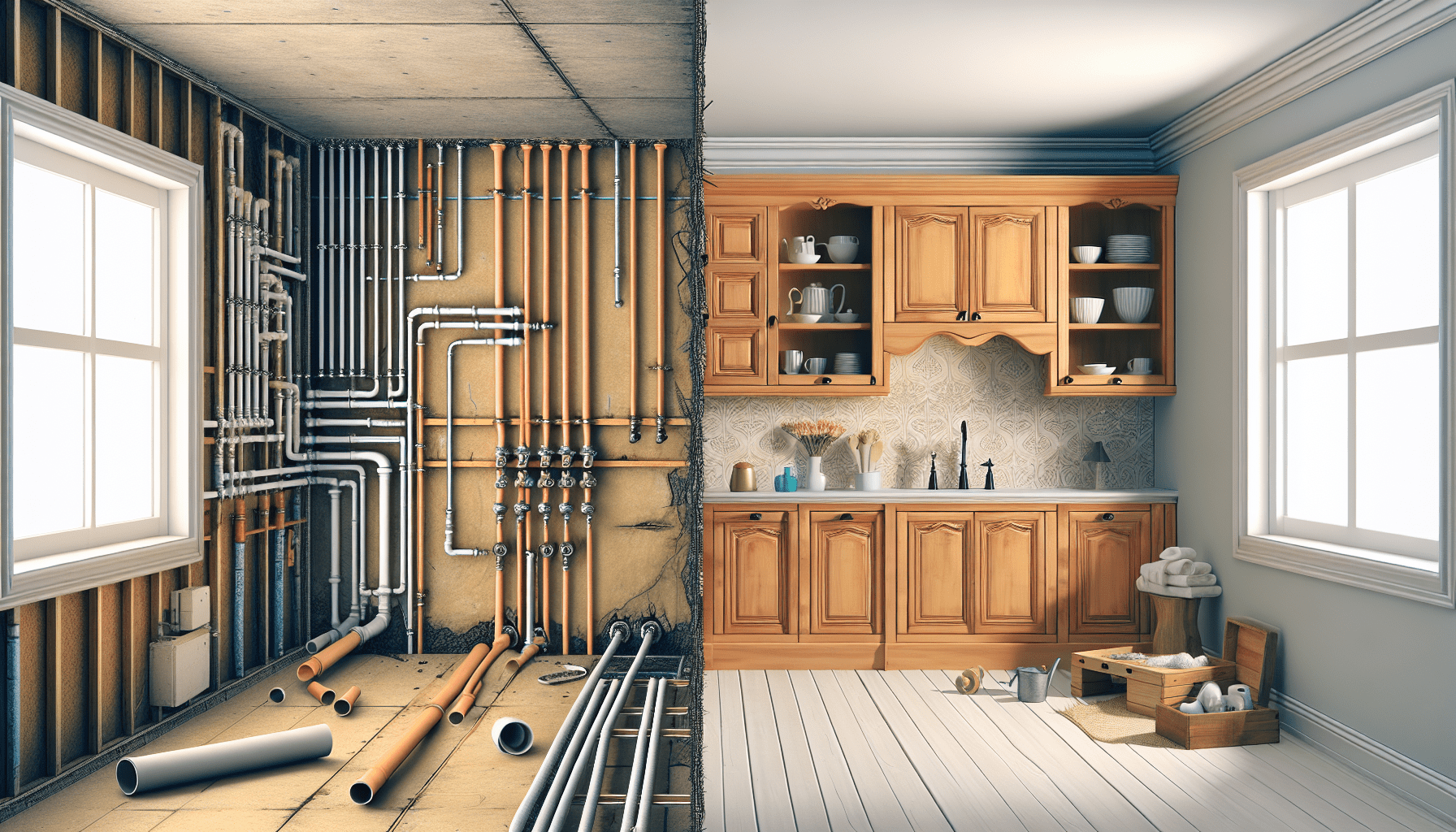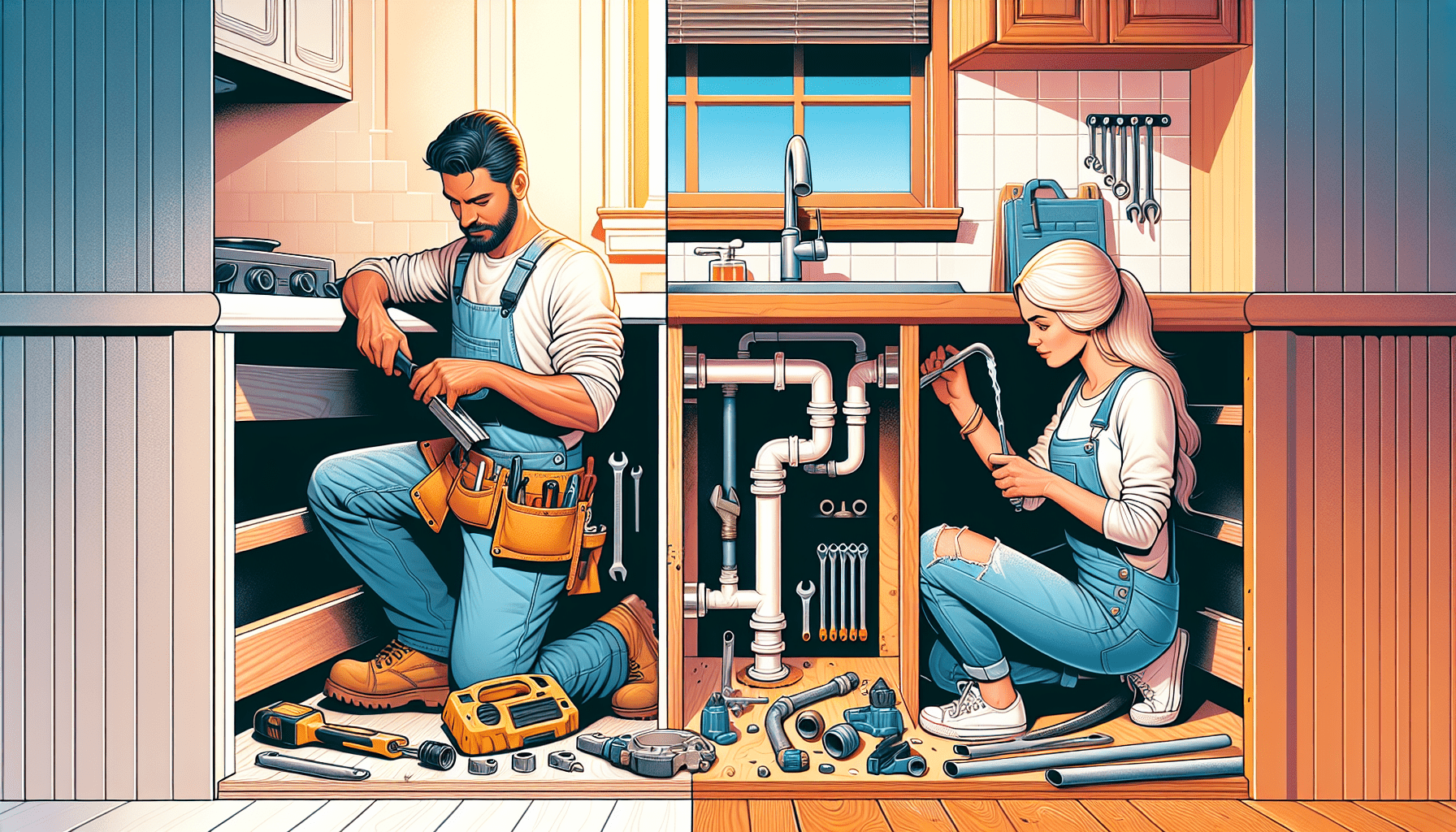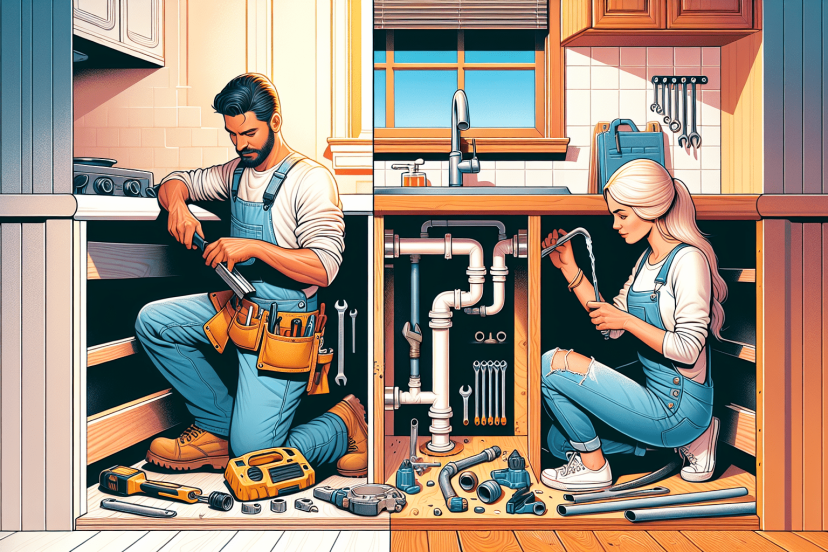Do You Do Plumbing Before Or After Cabinets?
Are you planning a kitchen renovation and wondering if you should tackle the plumbing before or after the cabinets? It’s a common dilemma that many homeowners face when undertaking this type of project. In this article, we will explore the pros and cons of both approaches, helping you make an informed decision that suits your needs. So whether you’re a DIY enthusiast or hiring a professional, read on to find out whether it’s best to do plumbing before or after cabinets in your kitchen renovation.
Understanding the Plumbing and Cabinet Installation Process
When it comes to home renovations or new construction projects, understanding the process of plumbing and cabinet installation is vital. These two components play a significant role in functional and aesthetic aspects of a home. In this article, we will delve into the factors to consider when deciding the order of plumbing and cabinet installation, the pros and cons of each approach, and provide a step-by-step guide for both methods. Additionally, we will offer some tips to ensure a smooth installation process and address common challenges that may arise.
Plumbing Installation Process
Before diving into the decision-making process, it’s necessary to understand the plumbing installation process. Plumbing involves the connection of water supply lines, waste pipes, and fixtures to ensure a functioning water and drainage system in your home. This process includes rough-in plumbing, where the basic framework of the plumbing system is installed, and the final plumbing installation, where fixtures such as faucets, sinks, and toilets are added.
Cabinet Installation Process
Cabinet installation focuses on creating storage and organization solutions in various areas of your home, such as the kitchen, bathroom, or laundry room. It involves the installation of pre-made or custom-built cabinets, which can be made from various materials like wood or laminate. The process includes measuring, leveling, attaching cabinets to walls, and adding doors and hardware for functionality and style.
Factors to Consider when Deciding the Order of Plumbing and Cabinet Installation
Determining whether to do plumbing before or after cabinet installation requires careful consideration of several factors. Let’s explore these factors to help you make an informed decision for your project:
Overall Project Timeline
One crucial factor to consider is the overall project timeline. If time is of the essence and you need your cabinets installed quickly, it might be more efficient to complete the plumbing installation before the cabinet installation. However, if there is flexibility in the timeline, you have the liberty to choose based on other factors.
Plumbing System Design
The design of your plumbing system can play a significant role in the decision-making process. For example, if the plumbing system requires complex configurations or unconventional access points, it might be easier to install the cabinets first and then connect the plumbing accordingly. On the other hand, if the design is straightforward and doesn’t require extensive modifications during the installation process, plumbing before cabinets could be a viable option.
Plumbing Access Points
Considering the locations of plumbing access points is important for both functional and aesthetic reasons. If the access points are relatively hidden or can be concealed within the cabinet design, plumbing before cabinets might be a suitable choice. However, if the access points are more prominent and would negatively impact the appearance of the cabinets, installing the cabinets first could be a better option.
Cabinet Design and Layout
The design and layout of your cabinets also play a crucial role in determining the order of installation. If the cabinets have specific requirements, such as built-in sinks or intricate plumbing connections, it may be more practical to install the cabinets first. On the other hand, if the cabinet design is basic and doesn’t require any plumbing integration, plumbing before cabinets may be a viable option.
Coordination with Other Trades
Consider the coordination required with other trades involved in your project. If other aspects, such as electrical or flooring, need to be completed before or after plumbing and cabinets, it’s important to evaluate how these trades will be affected by your decision. Open communication and coordination with all trades involved will help ensure a smooth and efficient installation process.

Plumbing Before Cabinets: Pros and Cons
Let’s explore the pros and cons of doing plumbing before cabinets:
Pros of Plumbing Before Cabinets
One significant advantage of completing the plumbing installation before cabinet installation is the ease of access and flexibility. Without cabinets in place, plumbers have more freedom to navigate and make adjustments during the rough-in plumbing and final installation stages. It also allows for easier connection of fixtures and makes any necessary repairs or modifications more accessible.
Another benefit is that plumbing before cabinets allows for better alignment of plumbing fixtures with the required access points. This ensures that pipes and drains are precisely positioned, avoiding any potential conflicts or inefficiencies when installing cabinets. Ultimately, this can contribute to a more seamless and functional layout in the long term.
Cons of Plumbing Before Cabinets
However, there are also some drawbacks to consider when choosing to do plumbing before cabinets. The installation of cabinets after plumbing can cause potential damage to the plumbing system. During cabinet installation, accidental drilling or modifications could lead to leaks or damage to pipes, requiring additional repairs and expenses.
Additionally, installing cabinets after plumbing may limit the available space for accessing or repairing plumbing systems in the future. Depending on the design of the cabinets, accessing pipes or making adjustments may require the removal or disassembly of cabinet units, making maintenance or repairs more complicated and time-consuming.
Cabinets Before Plumbing: Pros and Cons
Now, let’s delve into the pros and cons of installing cabinets before plumbing:
Pros of Cabinets Before Plumbing
Installing cabinets before plumbing allows for better visualizing the overall design and layout of the space. By having the cabinets in place, you can accurately assess how the plumbing fixtures and access points will align with the cabinetry. This can assist in making informed decisions about the placement of sinks, faucets, or appliances, ensuring optimal functionality and aesthetics.
Another advantage of cabinets before plumbing is that it reduces the risk of damage to the plumbing system during cabinet installation. With the cabinets already installed, there is less possibility of accidental drilling or modifications that could compromise the integrity of the pipes or cause leaks.
Cons of Cabinets Before Plumbing
One of the major drawbacks of installing cabinets before plumbing is the reduced accessibility for plumbers. With cabinets in place, working on the plumbing system becomes more challenging. This could lead to difficulties in connecting fixtures, making repairs, or addressing any issues that may arise during the installation process. Plumbers may need to work around the cabinets, potentially compromising the efficiency and accuracy of their work.
Another concern is the potential for misalignment between the plumbing fixtures and the cabinet design. In cases where the cabinets have specific requirements, such as built-in sinks or plumbing connections, there may be limitations on the available options or adjustments that can be made. This could impact the overall functionality and aesthetics of the space.

Determining the Best Approach for Your Project
Choosing the best approach for your project depends on various considerations. Here are a few key factors to help guide your decision:
Consulting with a Professional
It’s highly recommended to consult with a professional, such as an experienced contractor, plumber, or designer, to evaluate your specific project requirements. They can provide expert advice and insights based on their knowledge and experience, taking into account factors unique to your space, budget, and timeline.
Considering the Nature of the Project
The nature of your project can heavily influence the order of plumbing and cabinet installation. For example, if you are undergoing a complete renovation with extensive modifications to the plumbing system, it may be more practical to start with the plumbing installation before cabinets. Conversely, if you are focusing primarily on cabinet upgrades without significant plumbing changes, installing cabinets before plumbing could be a viable option.
Budget and Time Constraints
Evaluate your budget and time constraints when deciding the order of installation. The cost of any additional repairs or modifications resulting from the chosen approach should be factored into your budget. Consider the time required for each installation method and how it aligns with your project timeline. Balancing budget and time constraints is crucial to ensure a smooth and efficient installation process.
Step-by-Step Guide: Plumbing Before Cabinets
If you decide to opt for plumbing before cabinets, here is a step-by-step guide to help you navigate the process:
Initial Planning
Before starting any construction or installation work, it’s essential to create a detailed plan. Consult with a plumber to determine the precise locations for water supply lines, drainpipes, and fixtures based on your specific needs. Take accurate measurements and consider all necessary access points and connections.
Rough-In Plumbing
The rough-in plumbing stage involves installing the basic framework of the plumbing system. This includes laying the pipes for water supply and drainage and connecting them to the main lines. Ensure all connections are tight and secure, and adhere to local building codes and regulations. If any modifications or adjustments need to be made during this stage, consult with your plumber to avoid any conflicts with the cabinet installation.
Cabinet Installation
Once the rough-in plumbing is complete, proceed with the cabinet installation. Follow the manufacturer’s instructions carefully, ensuring accurate measurements, leveling, and secure attachment to walls. Double-check the alignment of cabinets with the designated plumbing access points to ensure a seamless integration when connecting fixtures.
Step-by-Step Guide: Cabinets Before Plumbing
For those opting for cabinets before plumbing, here is a step-by-step guide to guide you through the process:
Initial Planning
As with plumbing before cabinets, begin with a detailed initial planning phase. Consult with a designer or cabinet professional to determine the optimal layout and placement of your cabinets. Consider any specific design requirements or built-in fixtures that may impact the plumbing installation.
Cabinet Installation
Install the cabinets following the manufacturer’s instructions and guidelines. Ensure accurate measurements, proper leveling, and secure attachment to walls. Take into account any plumbing access points required for future installation and maintenance. It’s advisable to consult with a plumber at this stage to determine the best locations and positions for these access points to align with your cabinet design.
Rough-In Plumbing
Once the cabinets are securely installed, proceed with the rough-in plumbing. Consult with your plumber to determine the precise locations for water lines, drainpipes, and fixtures based on the cabinet layout. Install the necessary pipes and connections to align with the access points designated during the cabinet installation. Regular communication and coordination with your plumber throughout this stage are crucial to ensure accurate positioning and avoid conflicts between cabinets and plumbing fixtures.
Tips for a Smooth Plumbing and Cabinet Installation Process
To ensure a smooth installation process, here are some tips to consider:
Open Communication with Contractors
Maintain open and regular communication with all contractors involved in the project, including plumbers, cabinet installers, electricians, and other trades. Clearly communicate your expectations, project timeline, and any specific requirements. Regular updates and coordination will help prevent delays, conflicts, or misunderstandings.
Accurate Measurements and Planning
Take accurate measurements and create detailed plans before any installation work begins. This will minimize errors and ensure that all components fit precisely. Double-check all measurements and consult with professionals if you have any doubts or concerns.
Proper Coordination and Scheduling
Coordinate the schedule of various trades involved in your project to avoid overlapping or conflicting timelines. Consider the dependencies between plumbing and cabinet installation, as well as other trades like electrical or flooring. A well-coordinated schedule will help streamline the process and minimize delays.
Regular Inspections and Quality Control
Perform regular inspections throughout the installation process to ensure quality control and identify any potential issues early on. Address any concerns promptly to avoid additional repairs or adjustments later. This will help maintain the integrity and functionality of both the plumbing and cabinet systems.
Common Challenges and How to Overcome Them
While every project is unique, certain challenges tend to arise during plumbing and cabinet installation. Here are a few common challenges and some suggestions on how to overcome them:
Unforeseen Plumbing Issues
During the plumbing installation, unforeseen issues such as hidden leaks or damaged pipes can emerge. To mitigate these challenges, it is essential to work with a qualified plumber who can assess the situation and offer effective solutions. Building in some extra time and budget for potential contingencies can also help manage any unforeseen plumbing issues.
Finding Compatible Cabinets
Cabinet selection is a critical aspect of any project, and finding compatible cabinets that align with the plumbing fixtures and access points can be a challenge. Consult with a cabinet professional or interior designer who can guide you in selecting cabinets that meet your design requirements while allowing for proper integration with the plumbing system.
Ensuring Proper Cabinet Alignment with Plumbing Fixtures
When installing cabinets before plumbing, precise alignment between cabinets and plumbing fixtures is crucial. Work closely with your plumber and cabinet installer to ensure accurate measurements and alignment. Regular inspections during the installation process will help identify and address any misalignments promptly.
Minimizing Damage and Repairs
Accidental damage to plumbing systems or cabinets during installation can occur. To minimize potential damage, it’s crucial to hire experienced and skilled professionals for both plumbing and cabinet installation. Additionally, implementing proper safety measures, such as covering or protecting plumbing fixtures and cabinets during construction, can help prevent unnecessary repairs or replacements.
Final Considerations and Summary
Understanding the plumbing and cabinet installation process lays the foundation for a successful home renovation or construction project. Consider the factors discussed, such as the overall project timeline, plumbing system design, access points, cabinet design, and coordination with other trades, to determine the order of installation that best suits your project’s needs. Be sure to consult with professionals, take accurate measurements, and maintain open communication with contractors throughout the process. By following these guidelines, you can overcome common challenges and achieve a seamless and efficient plumbing and cabinet installation.




